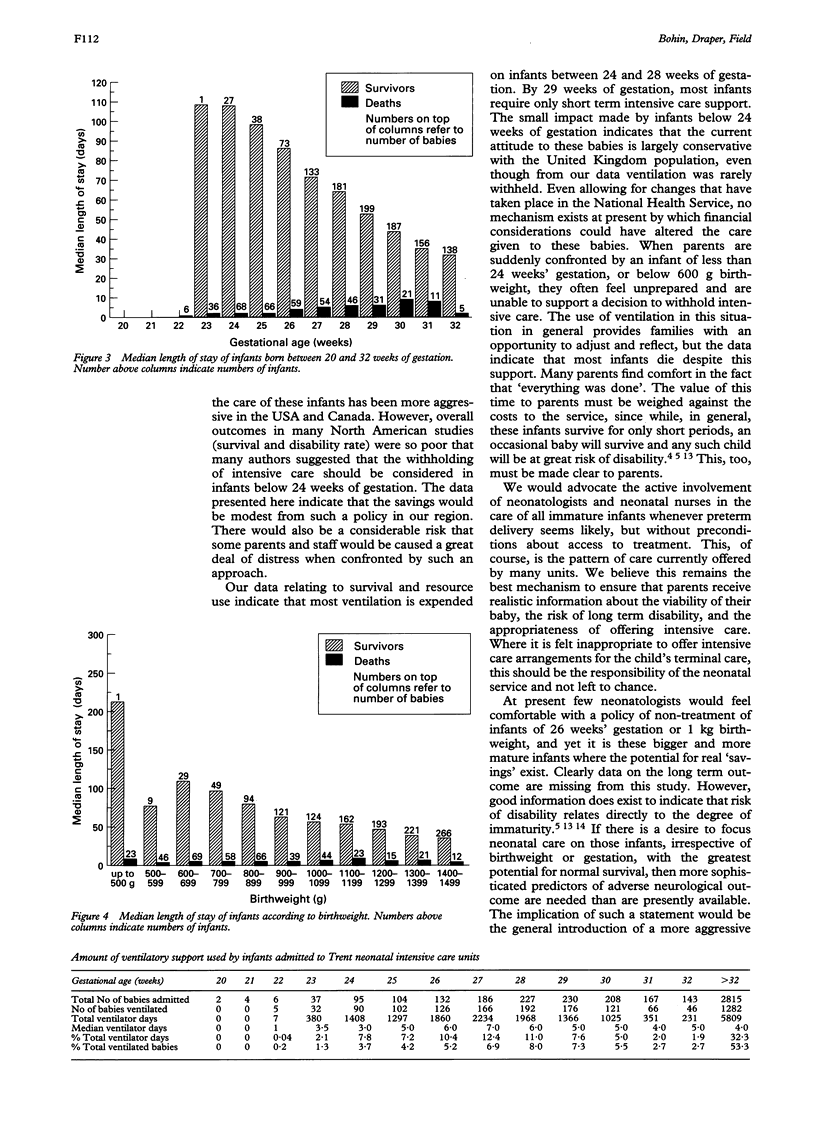Abstract
The impact of very immature infants on neonatal services was examined within the United Kingdom. The Trent Health Region was used as a geographically defined population. Data were obtained on all infants weighing less than 1501 g at birth and all infants born before 32 weeks gestation between 1991-93. Information relating to length of stay, duration of ventilation, and survival was documented. Only one of 49 infants born before 24 weeks gestation survived. However, 75% of this group were ventilated. Most of the remaining infants died before 48 hours of age. A similar pattern was also seen in infants of 24 and 25 weeks gestation. Infants under 24 weeks gestation comprised 1.5% of all ventilated infants and consumed 2.14% of the total neonatal ventilator days for the region. It is concluded that the United Kingdom operates a conservative policy towards infants born before 24 weeks gestation and as a result resources expended on them are limited.
Full text
PDF



Selected References
These references are in PubMed. This may not be the complete list of references from this article.
- Alberman E., Botting B. Trends in prevalence and survival of very low birthweight infants, England and Wales: 1983-7. Arch Dis Child. 1991 Nov;66(11):1304–1308. doi: 10.1136/adc.66.11.1304. [DOI] [PMC free article] [PubMed] [Google Scholar]
- Allen M. C., Donohue P. K., Dusman A. E. The limit of viability--neonatal outcome of infants born at 22 to 25 weeks' gestation. N Engl J Med. 1993 Nov 25;329(22):1597–1601. doi: 10.1056/NEJM199311253292201. [DOI] [PubMed] [Google Scholar]
- Campbell A. G. Which infants should not receive intensive care? Arch Dis Child. 1982 Aug;57(8):569–571. doi: 10.1136/adc.57.8.569. [DOI] [PMC free article] [PubMed] [Google Scholar]
- Hack M., Fanaroff A. A. Outcomes of extremely-low-birth-weight infants between 1982 and 1988. N Engl J Med. 1989 Dec 14;321(24):1642–1647. doi: 10.1056/NEJM198912143212405. [DOI] [PubMed] [Google Scholar]
- Hack M., Horbar J. D., Malloy M. H., Tyson J. E., Wright E., Wright L. Very low birth weight outcomes of the National Institute of Child Health and Human Development Neonatal Network. Pediatrics. 1991 May;87(5):587–597. [PubMed] [Google Scholar]
- Hack M., Taylor H. G., Klein N., Eiben R., Schatschneider C., Mercuri-Minich N. School-age outcomes in children with birth weights under 750 g. N Engl J Med. 1994 Sep 22;331(12):753–759. doi: 10.1056/NEJM199409223311201. [DOI] [PubMed] [Google Scholar]
- Johnson A., Townshend P., Yudkin P., Bull D., Wilkinson A. R. Functional abilities at age 4 years of children born before 29 weeks of gestation. BMJ. 1993 Jun 26;306(6894):1715–1718. doi: 10.1136/bmj.306.6894.1715. [DOI] [PMC free article] [PubMed] [Google Scholar]
- Lantos J. Baby Doe five years later. Implications for child health. N Engl J Med. 1987 Aug 13;317(7):444–447. doi: 10.1056/NEJM198708133170709. [DOI] [PubMed] [Google Scholar]
- Veen S., Ens-Dokkum M. H., Schreuder A. M., Verloove-Vanhorick S. P., Brand R., Ruys J. H. Impairments, disabilities, and handicaps of very preterm and very-low-birthweight infants at five years of age. The Collaborative Project on Preterm and Small for Gestational Age Infants (POPS) in The Netherlands. Lancet. 1991 Jul 6;338(8758):33–36. doi: 10.1016/0140-6736(91)90015-h. [DOI] [PubMed] [Google Scholar]
- Whyte H. E., Fitzhardinge P. M., Shennan A. T., Lennox K., Smith L., Lacy J. Extreme immaturity: outcome of 568 pregnancies of 23-26 weeks' gestation. Obstet Gynecol. 1993 Jul;82(1):1–7. [PubMed] [Google Scholar]


